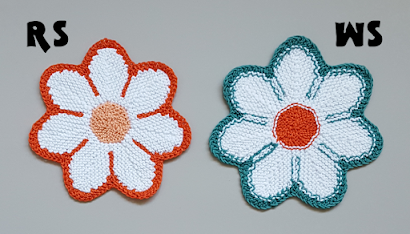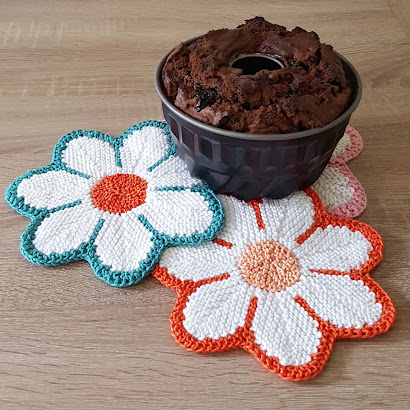After a few really warm days in September, it's finally getting colder and wetter outside. For me, that's the moment where I really like to stay inside, make myself comfortable and have it cozy. Part of this is a bit of seasonal decoration and somehow the pumpkin is the ultimate autumn decoration (even though I cannot remember eating it as a child). That's why I decided to knit little decorative pumpkins, using old yarn that was already in my stash. (The light orange ones are made from yarn, that was leftover when my Mum knitted a sweater in the 70ies :)
As it is my usual go-to construction (e.g. here or here), I knitted them sideways - starting with a provisional CO, shaping the piece with short rows and finishing by grafting in garter stitch. If you want to learn one of these techniques, this might be a project to learn.
This is a project a bit like my little knitted hearts (Herzchen) - once you start knitting them, you cannot stop :)

This work by
Knitting and so on is licensed under a
Creative Commons Attribution-NonCommercial-ShareAlike 4.0 International License.

Size
The pumpkins I knitted measured between 6 and 11 cm in diameter - depending on yarn (fingering, to fingering held double) and needles that I used (2.25 to 3.5 mm).
Materials
- yarn – basically leftovers - I different kinds of yarn – and self-striping fingering weight yarn)
- knitting needles – dpns knitting needles, circulars or AddiTrios (both will work for the flat piece and for the i-cord), always smaller needles than the yarn called for – in order to get a tight texture, e.g. 2.25 mm for fingering weight yarn or 3.5 mm for fingering yarn held doubly
- a crochet hook (for the provisional cast-on)
- stuffing - I used the yarn ends and fabric scraps that I had saved from previous knitting or sewing projects
- a tapestry needle for grafting and weaving in ends
Techniques
Instructions
Pumpkin
With scrap yarn, do a provisional CO of 18 stitches and with your working yarn (see illustration 1), knit the setup row (k all, see illustration 2).
Ridge 1 (RS/WS): sl, k1, kfb, k1, kfb, k2, kfb, k2, kfb, k1, kfb, k1, kfb, k1, w+t, k20 (or k to 2 bef end), w+t
Ridge 2 (RS/WS): k5, kfb, k8, kfb, k3 (i.e. 4 bef end), w+t, k15, (i.e. 7 bef end) w+t
Ridge 3 (RS/WS): k10, w+t, k13 (i.e. 4 bef end), w+t
Ridge 4 (RS/WS): k15, w+t, k11, w+t
Ridge 5 (RS/WS): k10, w+t, k12 (i.e. 6 bef end), w+t
Ridge 6 (RS/WS): k14 (i.e. 6 bef end), w+t, k15 (i.e. 5 bef end), w+t
Ridge 7 (RS/WS): k1, ssk, k10, ssk, k1 (i.e. 5 bef end), w+t, k11, w+t
Ridge 8 (RS/WS): k10, w+t, k15 (i.e. 3 bef end), w+t
Ridge 9 (RS/WS): ssk, k1, ssk, k1, ssk, k1, ssk, k1, ssk, k1, ssk, k1 (i.e. 3 bef end), w+t, k14 (i.e. 1 bef end), w+t
Ridge 10: k17, turn, sl1, k17 (i.e. to end)
 |
Illustrations
|
After the first repeat of these 10 ridges you're back to 18 stitches on your needles and the piece will look similar to illustration 3.
Repeat ridges 1 to 10 four more times, then knit ridges 1 to 8 - and a slightly altered version of ridge 9 (i.e. ridge 9b), knitting the WS row to end - or spelled out:
Ridge 9b (RS/WS): ssk, k1, ssk, k1, ssk, k1, ssk, k1, ssk, k1, ssk, k1, ssk, k1, w+t, k to end
Remove the scrap yarn of the provisional CO and catch the stitches on a knitting needle. As you can see on illustration 4, the right edge of the piece is 6 rows high. That's why you first have to close up the (potential) hole at the end of the row. Then start grafting the live stitches together in garter stitch.
When you've closed about two thirds of the row, fill the pumpkin with stuffing. Continue grafting in garter stitch to the end of the row. With the same tail, close the other (potential) hole. Then stick the needle right through the middle of the piece, and then back (illustration 5). Pull the yarn tight. That will make the piece a bit flatter and therefore more pumpkin shaped. Secure tail and weave in ends.
Please note:
- It may be helpful to mark the RS of the piece.
- When I knitted these, I sometimes miscounted my stitches. This doesn't really matter, as long as you're not too far out (and anyway, real pumpkins aren't completely symmetrical, are they?). But that's why I've included the instructions until which stitch some of the ridges are to be knitted (e.g. k to 2 bef end). This may help you to get back in sync with the pattern after having miscounted.
Stem
In contrasting yarn, knit an i-cord (of 5 stitches) of about 12 rows (or however long you want the stem), cut yarn, but leave a tail that's long enough to sew stem to pumpkin.
Use the tail to sew the stem to the pumpkin (illustration 6) and weave in ends.






























